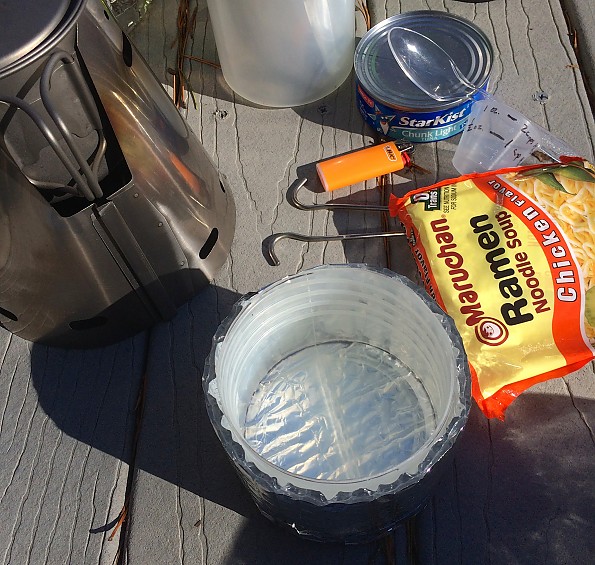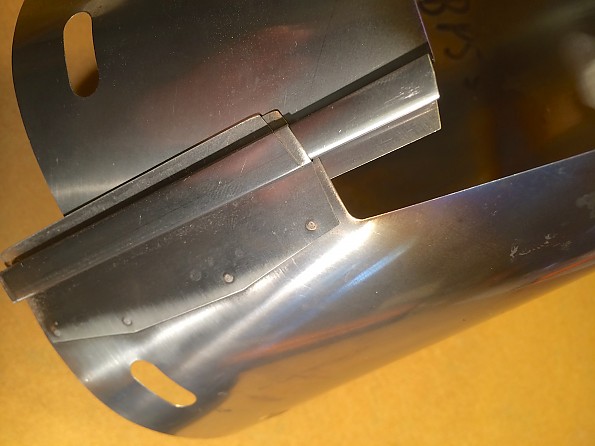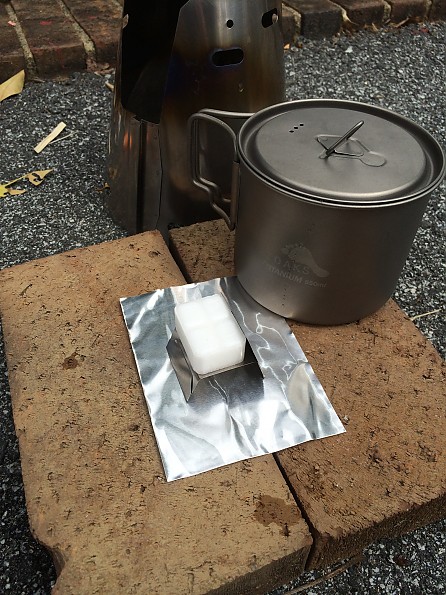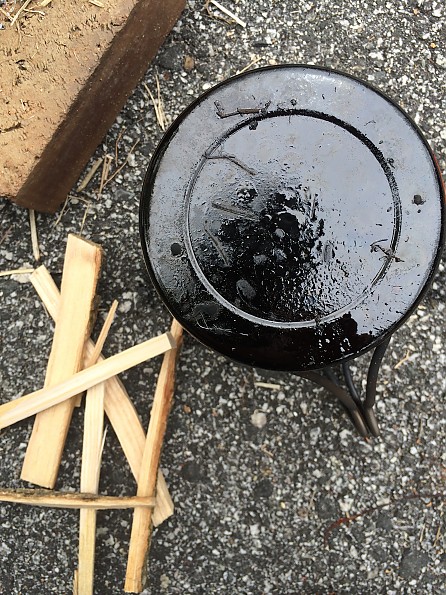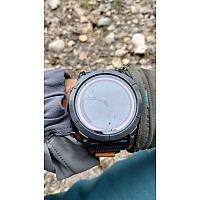Trail Designs Classic Ti-Tri

The Trail Designs Classic Ti-Tri stove system offers a pot stand, a windscreen, and three fuel choices—alcohol, Esbit, wood—in a durable, lightweight package. Best for lightweight or ultralight backpackers hiking in conditions that make these fuel options viable and practical.
Pros
- Superior design and craftsmanship
- 3 fuel options
- Excellent wind protection
- Low weight
- Excellent stability
Cons
- Cost: good value, but beyond some budgets
- Packability: other systems back down better
The search for the perfect backpacking stove is virtually endless: for we DIYers and MYOG junkies, the endless array of stoves that can be made in one's workshop (or even on the trail) offer low cost and the satisfaction of having made something oneself, be it an alcohol stove made from a beer can or a gasifier wood-burner made from a soup can and a paint can.
The market is flooded with countless commercial options, too, a bewildering array. Each has its own pros and cons. So we play with options, fill shelves and drawers with creations and purchases, and keep on searching. Been there, done that.
As I began to lean toward alcohol systems for rehydrating food, I began to come across frequent mention of the Trail Designs Caldera Cone, something praised in almost every review I found. Intrigued, I turned to YouTube and found plans to make my own aluminum cone for my Snow Peak Mini Solo pot to test the concept out. I immediately appreciated the stability the cone design offered, and the tapering of the cone seemed to channel heat efficiently around the pot itself.
But the idea of having wood as a fuel option appealed to me, and my homemade aluminum cone couldn't handle the heat of a wood fire. I had decided to bite the bullet on the Trail Designs system when Santa beat me to it (an e-mail comment from Rand Lindsly of Trail Designs: "Someone must really like you . . . great present! :-) ).
And so the system that currently reigns in my kit is Trail Designs Classic Ti-Tri, one of their caldera cone systems that features three different fuel options.
For those who don't know about Trail Designs, here is the company's own description from their web site: "Trail Designs LLC specializes in the design, manufacture, and distribution of lightweight and ultralightweight backpacking gear. Our mission is to deliver the lightest backpacking systems on the market through innovative design and manufacturing."
The company, which was formed after its founders grew frustrated with existing gear options, was "the vision of three Northern California backpacking mechanical engineers." I have found customer service to be excellent: an e-mail inquiry received a response in a matter of hours from Rand Lindsly, one of the founders. My question was answered throughly in language that conveyed Rand's passion and enthusiasm for backpacking and his products.
The Classic Ti-Tri is one of several options in their range of titanium, multi-fuel stove systems. I suppose it might be termed the entry model, save that it is fully featured, and the phrase "entry model" holds negative connotations (corners cut, features absent, etc.). The Classic Ti-Tri cuts no corners: if it is an entry model, it is due to its packability; unlike other Trail Designs Ti-Tri options, the Classic does not fit completely inside of the pot for which it is designed (more on pots later).
Other incarnations include two-part cones that roll up inside pots or a model that can be placed in a roll in the bottom of a wide pot. This is a tradeoff: the single-piece construction is easy to use and quick to set up; it is also more bulky. Whereas other Ti-Tri options nestle in pots, the Classic comes with a plastic caddy that—as Trail Designs notes—can double as bowl and mug. I've used the smaller portion of the caddy as a bowl, lining it with a freezer bag for heating food. It worked fine in this capacity, and, since I used the bag, there was no clean-up required. By coincidence, the insulated pot cozy I made for the caddy also fit my TOAKS 550 ml pot, making this a more viable option.
The Ti-Tri stoves come with additional options, too: Leave No Trace devotees will appreciate the titanium floor options (one-piece or two-piece); wood-burners may be intrigued by the Inferno option, which "turns your Ti-Tri into a wood burning gassifier/afterburner"; or a titanium simmer ring for the 12-10 alcohol stove. Each option naturally adds more to one's cost, but Trail Designs offers discounts for package deals, including discounts on compatible pots when a system is purchased.
Why just compatible pots, and not all pots? Because each cone is custom-engineered for a particular pot so that the circumference of the cone's upper rim matches the circumference of the pot, and so the distance between the 12-10 alcohol stove and the bottom of the pot is optimized for maximum performance. The lip of the pot rests on the rim of the cone, creating an efficient seal (except where the opening for the pot handle is located). The Trail Designs web site lists the models for which these Ti-Tri systems are available; I'll spare you that list here.
What comes with the Classic Ti-Tri?
- a two-piece, threaded plastic caddy (75g/2.65 oz)
- titanium caldera cone (for TOAKS 550ml: 36g/1.27 oz)
- 12-10 alcohol stove with integrated primer pan (15g/.53 oz)
- 5.5 oz plastic fuel bottle with reducer and O-ring seal (empty 20g/.71 oz; full: 141g/4.97 oz))
- plastic fuel measuring cup (1g/.04 oz)
- 2 titanium tent stakes (2x 6g/.21 oz)
- three-piece GramCracker solid-fuel unit (3g/.11 oz)
- protective foil shield for GramCracker unit (4g/.14 oz)
- 3 Esbit solid fuel tablets (3x 15g/.53 oz)
- heavy duty, resealable plastic bag for GramCracker components (4g/.14 oz)
- Detailed directions for each component
In my case, this system was designed for the TOAKS titanium 550ml pot. Materials and workmanship are of superior quality. The detail photograph below of the fastening mechanism for the caldera cone--essentially, a smaller raised channel that fits inside another raised channel--reveals a second piece of titanium is welded to the cone to reinforce this critical joint. All edges appear precisely manufactured. The titanium itself is resilient and feels durable (no issues thus far).
There are nice details: the fuel bottle includes a reducer to allow one to squirt the fuel in controlled doses from the bottle; the O-ring in its cap offers piece of mind against spills. The GramCracker stove is designed to accommodate multiple set-ups for fastest combustion, a medium burn rate, and a most efficient burn rate. The side panels of this kit also permit the stacking of solid fuel tablets to for use with larger capacity pots. The tent stakes can easily be stowed for one's tent or tarp (they look a lot like TOAKS titanium sphere's hook stakes) and thus can serve multiple uses, great if one is shaving grams.
The basic operation is similar for all three fuel options: the fuel is ignited, the cone is placed over the fuel, and the pot is placed in the top of the caldera cone. For alcohol use, the 12-10 stove is filled with denatured alcohol (no more than 40ml). Unlike some soda can stoves, the 12-10 concentrates its flames in the round opening at the top center of the stove; the holes around the exterior perimeter draw oxygen in for the flames.
Trail Designs indicates that the 12-10 stove will bring 2 cups of water to a boil with 15-20ml of fuel, a claim that has held true in my own testing and use. In colder weather, 15-20 drops of alcohol can be added to the primer pan of the fueled stove and then lit; this is an option I have not needed to use despite cold weather use.
For purposes of this review, I tested each fuel method side-by-side to determine how long each would take to boil two cups of cool tap water (sorry, I couldn't find an immersion thermometer) on a 52˚F, party-cloudy, moderately windy day.
The 12-10 alcohol stove was loaded with 20 ml of fuel and heated the water to a boil in about 7 minutes and 10 seconds. The burning left no residue on the bottom of the pot, a consideration when packing gear day after day. This is my go-to method of boiling water. Owing to variables I'll mention later, I prefer alcohol as the fuel to other fuels (of course those who pack 190-proof rectified spirits may find other reasons to prefer this fuel mode!).
I've used the Classic Ti-Tri in sun, rain, and snow and it performed beautifully (see third and fourth of next four images). Some may debate the pros of carrying alcohol beyond a certain number of days, arguing that the fuel weight for many meals outweighs the benefits of an alcohol system when compared to other systems. I'm going to sidestep that debate and focus on tests.
From the moment that the Esbit tablet caught fire, the GramCracker test took 8 minutes and 28 seconds to boil the two cups with the unit set up for the medium position--one side up on the burner platform. In the wind, the Esbit was a bit challenging to ignite, but once lit it burned nicely, though in less focused fashion than the 12-10 alcohol stove. The typical chemical odor of solid-fuel tablets emanated from the cone during this test; some may find this off-putting. I like the security of carrying Esbit, though; if I were to run out of alcohol in a sodden forest, Esbit would give me a way to boil my water. Residue on the pot bottom washed off easily after the Esbit test.
One perk of writing this review is that it finally induced me to test this system as a wood-burner. I plan to purchase the Inferno insert (when I do I will emend this review), and so I have delayed playing with the wood-burning option before, but I decided I needed to test it now to be thorough. So lastly I tested two different modes for wood burning.
The Trail Designs setup requires the two tent stakes to slip through holes in the caldera cone to form a platform for the pot. This in turn creates an ample space for feeding the fire inside the cone. It also leaves that fire a bit more exposed to the elements. As with the preparation for any fire, I began by processing materials for that fire. For these tests I cut, battoned, and then further split some hardwood from a tree I felled a few months ago. I used dried grass as tinder supplemented by some strips of birch bark I tore up. No man-made accelerants were used.

Once I was assured that the fire was ignited, I covered it with the caldera cone and pot and fed the blaze from the opening created by the handle vent, starting the timer as I did so. Heating water with fire this time was a little tricky as the fire required constant feeling, and—as the directions indicate—the Caldera Cone is not optimized in this format for wood-burning (that is what the Inferno add-on insert is for). That said, the two cups boiled in 9 minutes 20 seconds, and the smell and sight of the wood fire was satisfying. Under optimal (dry) conditions (or with mad wet-weather fire-builing skills), using this configuration of the Ti-Tri system is a viable and welcome option. I could see myself deliberately using wood for the delight of the fire during unhurried sojourns in the backcountry.
For my final configuration, the Caldera Cone was to set up as I would set it up for alcohol or Esbit (pot lowered to the top of the caldera cone), but I used wood again as the fuel, feeding sticks through a slim opening beneath the pot handles or adding slivers of wood through the air slot in the base of the cone. My impulse here was curiosity, imagining a situation in which rain might make unwelcome the larger opening on the cone created by the proper set-up on the tent stakes.
My wood was sufficiently thin to accomplish this test, and I was astonished to see the water boiling in six minutes and 25 seconds. Clearly this was more efficient than the more easily fed, prescribed technique, and the heat generated appeared more intense than that of the alcohol or Esbit; it made me curious about the Inferno add-on option (are you listening, Santa?). Needless to say, both fire experiments left soot on the bottom of the pot. No, it didn't come off easily, but then a black pot is more heat-efficient anyway, right? ;)
My wood fire testing was done under reasonably optimal conditions, aside from the gusty wind that seemed to blow about in random fashion. Swirling wind does affect the fire in the cone, making a constant heat challenging to maintain, though it also blasts oxygen into the flames.
I don't have much experience yet with the cone as a wood burner, but the cone's design gives a definite edge to the cone over pit fires I've used for cooking--it offers a measure of wind protection and shelter from the elements, and--as with the other fuel methods--helps to concentrate the heat toward the cooking vessel. Any wood fire cooking option is subject to the variables one finds in nature affecting one's fuel sources; what makes the Classic Ti-Tri nice is the ability to have alcohol and Esbit back-ups if things don't go as planned.
Of the three, I like the cleanest burning alcohol for my day tripping and backpacking, and the light weight of the Classic Ti-Tri system means that I carry this with me whenever I head out for the woods. Set-up is a breeze, clean-up non-existent. If I ever find myself in so much of a rush to boil water that I can't wait seven minutes for it to heat, I will have betrayed my reasons for seeking nature anyway!
The Classic Ti-Tri is rock solid in alcohol mode, rain or shine, wind or no wind. It works great with Esbit, too, but I'll reserve that for emergencies: the odor seems intrusive and out-of-place when I am in natural surroundings, and the residue, while easily cleaned, nevertheless requires an added step to meal clean-up. But I will always have a weakness for wood fires. There is a romance to the flames, something soul-satisfying in the aroma of wood smoke.
Given an absence of urgency, I'd opt for wood as my second preferred choice. It will blacken my pot and make more work for me, but it offers a quintessential outdoor experience that Esbit can't match. Besides, I love using axes, saws, and knives to process wood for fires, and this Classic Ti-Tri--even without the Inferno add-on--can get the job done.
Beginning at $79.95, the Classic Ti-Tri is on the pricey side; it isn't for every budget. Housed (at least initially) in its caddy, it takes up more space than stove systems that fit into a pot. Should you be inclined to invest in this system, you will get a well-conceived, well-built three-fuel system for the pot of your choice. Each component of the system works well, though each fuel has its pros and cons, as I have suggested previously.
Prospective buyers should visit the Trail Designs website, though, as other similar systems such as the Sidewinder, Fissure, or Fusion Ti-Tri may offer greater packability than the Classic Ti-Tri, and the site also offers more detailed explanations and photographs of add-ons such as the Inferno wood-burning option or the 12-10 stove's titanium simmer ring.
Source: received it as a personal gift
Your Review
Where to Buy
You May Like
Specs
| Price |
MSRP: $79.95 |
| Fuel |
alcohol, solid fuel tabs, wood |
| Weight |
27-69 g (Ti-Tri Cone), 11-35 g (Inferno Cone), 10-33 g (grates), 9-40 g (Floors) |




